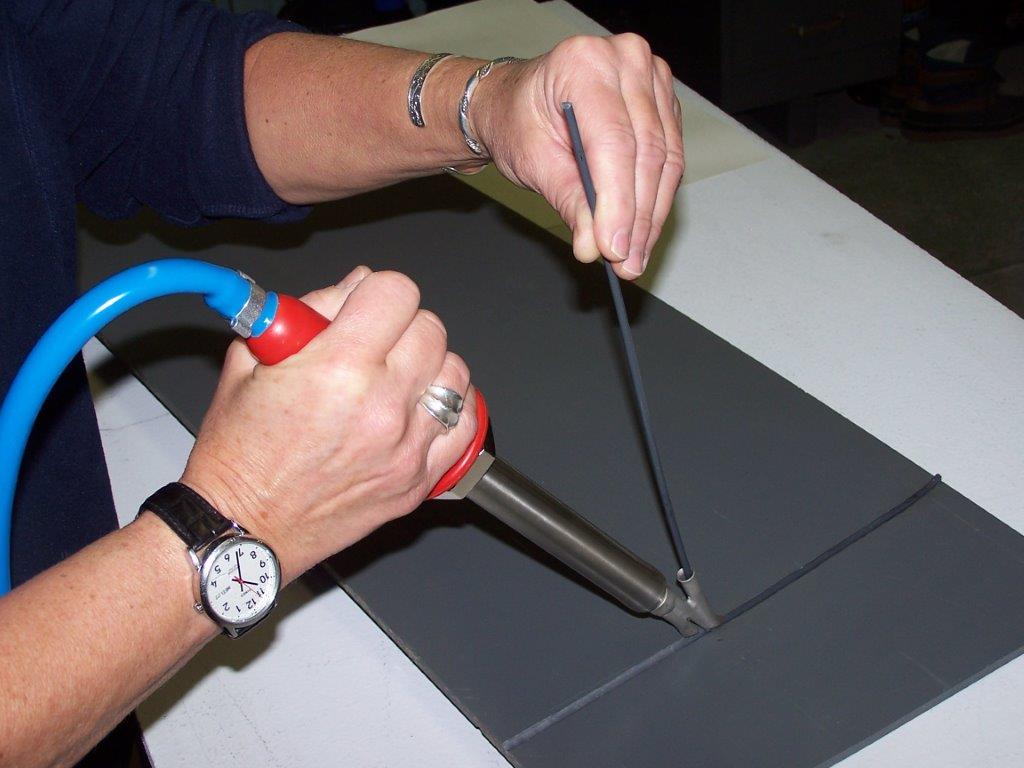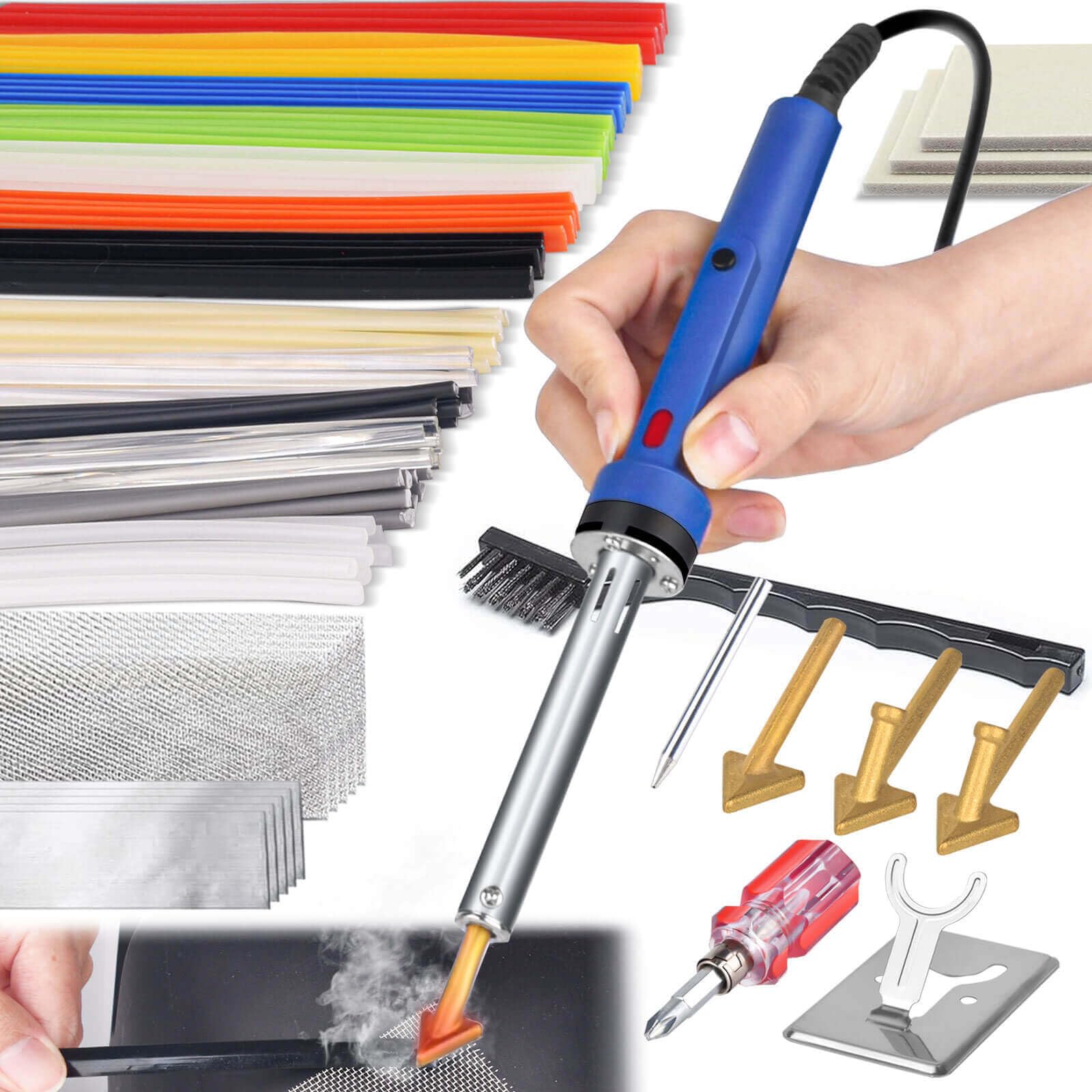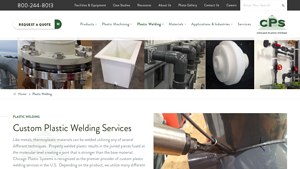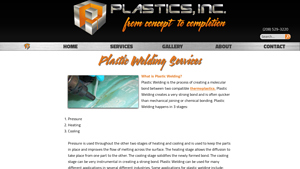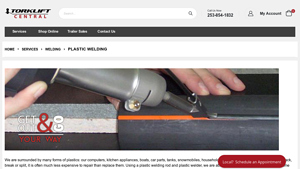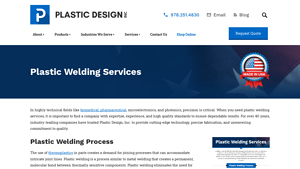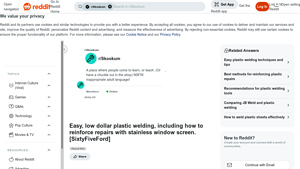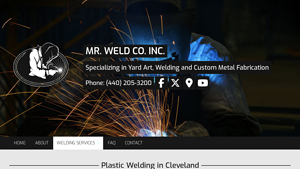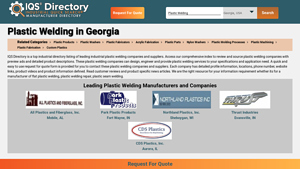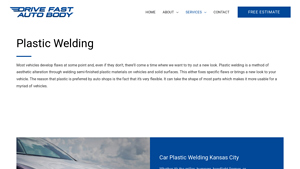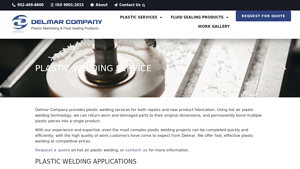Plastic Welding Service Guide: Type, Cost, Top List…
Introduction: Navigating the Global Market for plastic welding service
In the dynamic landscape of international trade, sourcing reliable plastic welding services can pose a significant challenge for B2B buyers. The complexity of selecting the right provider—one that not only understands the nuances of various thermoplastics but also delivers high-quality, cost-effective solutions—can be daunting. This guide aims to demystify the global market for plastic welding services by exploring a range of topics, including the different types of welding techniques, key applications across industries, and essential criteria for supplier vetting.
Understanding the intricacies of plastic welding is crucial for businesses in sectors such as aerospace, automotive, and medical manufacturing, where precision and durability are paramount. This comprehensive resource is designed specifically for international B2B buyers from regions like Africa, South America, the Middle East, and Europe, including emerging markets like Vietnam and Nigeria. By providing actionable insights into cost structures, industry standards, and best practices, this guide empowers decision-makers to make informed purchasing choices.
Whether you are looking to repair existing components or fabricate new products, navigating the complexities of plastic welding services has never been easier. With the right knowledge and tools at your disposal, you can ensure that your business remains competitive and responsive to the ever-evolving demands of the global market.
Understanding plastic welding service Types and Variations
| Type Name | Key Distinguishing Features | Primary B2B Applications | Brief Pros & Cons for Buyers |
|---|---|---|---|
| Hot Gas Welding | Utilizes hot air to soften thermoplastics, requires filler material | Chemical tanks, plumbing fittings, cleanroom equipment | Pros: Versatile, effective for various thicknesses; Cons: Quality depends on operator skill. |
| Extrusion Welding | Uses a handheld extruder to apply filler material for thicker joints | Heavy-duty applications, large tanks, structural components | Pros: Ideal for thick materials, strong welds; Cons: Slower process, requires specialized equipment. |
| Speed Tip Welding | Fast, soldering iron-like tool for quick welds in tight spaces | Small component assembly, repairs in confined areas | Pros: Quick and efficient; Cons: Limited to smaller applications. |
| Bead Welding | Involves laying down beads of melted plastic for joining | Tanks for plating, wastewater treatment, and chemical processing | Pros: Suitable for large surfaces; Cons: Requires precision to avoid defects. |
| Laser Welding | Uses laser technology for precise, clean welds | High-tech industries like aerospace and medical devices | Pros: High precision, minimal thermal impact; Cons: Higher cost, requires specialized setup. |
What are the Characteristics of Hot Gas Welding?
Hot gas welding is a widely utilized method that employs a jet of hot air to soften thermoplastic materials, allowing for the application of a compatible filler rod. This technique is particularly effective for joining thinner materials and is commonly used in industries requiring quick repairs or new fabrications, such as plumbing fittings and chemical tanks. Buyers should consider the operator’s expertise, as the quality of the weld is highly dependent on their skill level.
How Does Extrusion Welding Differ from Other Methods?
Extrusion welding is specifically designed for thicker materials, typically over 6 mm, where a handheld extruder feeds a filler rod into the joint while simultaneously applying heat. This method is ideal for heavy-duty applications, such as large containment tanks and structural components. Buyers should evaluate the need for robust joints, as this method provides excellent strength but may require more time and specialized equipment.
Why Choose Speed Tip Welding for Small Projects?
Speed tip welding is a fast and efficient technique that resembles soldering, making it suitable for small parts and repairs in tight spaces. This method allows for quick application of a molten bead of filler material, which is particularly useful in assembly processes. B2B buyers should consider the scale of their projects, as this method excels in speed but is limited to smaller applications.
What Are the Advantages of Bead Welding?
Bead welding involves the application of melted plastic in bead form, making it ideal for larger surface areas, such as tanks used in plating and wastewater treatment. This method requires precision to ensure a strong bond without defects. Businesses should assess the size of the components being welded, as this method is well-suited for larger applications but may require careful control during the process.
When is Laser Welding the Best Option?
Laser welding employs advanced laser technology to create precise, clean welds with minimal thermal impact on surrounding materials. This technique is particularly beneficial in high-tech sectors such as aerospace and medical devices, where precision is paramount. Buyers should weigh the benefits of accuracy against the higher costs associated with this method, as it often requires specialized equipment and expertise.
Key Industrial Applications of plastic welding service
| Industry/Sector | Specific Application of Plastic Welding Service | Value/Benefit for the Business | Key Sourcing Considerations for this Application |
|---|---|---|---|
| Aerospace | Repair of Aircraft Components | Enhances safety and extends lifespan of critical parts | Compliance with aviation standards and certifications |
| Chemical Processing | Manufacturing of Chemical Storage Tanks | Prevents leaks and ensures safety in hazardous environments | Material compatibility and resistance to chemicals |
| Food & Beverage | Fabrication of Sanitary Equipment | Meets hygiene standards and increases operational efficiency | Certification for food safety and quality control |
| Medical Devices | Assembly of Medical Equipment | Ensures precision and reliability in critical applications | Compliance with medical regulations and quality assurance |
| Oil & Gas | Repair of Pipeline Components | Minimizes downtime and reduces repair costs | Availability of specialized materials and technical expertise |
How is Plastic Welding Service Used in the Aerospace Industry?
In the aerospace sector, plastic welding services are crucial for the repair and maintenance of aircraft components. This process allows for the joining of thermoplastic materials that may have been damaged, ensuring the integrity and safety of critical parts. Buyers in this industry must consider the stringent compliance requirements with aviation standards, as well as the need for certified materials and skilled technicians to perform the welding.
What are the Benefits of Plastic Welding in Chemical Processing?
In chemical processing, plastic welding is extensively used for creating and repairing chemical storage tanks. This application is vital for preventing leaks and ensuring safety in environments that handle hazardous materials. International buyers should focus on sourcing materials that are chemically resistant and ensure compatibility with the specific substances being stored, as well as the availability of experienced fabricators who understand industry regulations.
How Does Plastic Welding Enhance Food & Beverage Equipment?
Plastic welding plays a significant role in the fabrication of sanitary equipment within the food and beverage industry. This technique ensures that joints are seamless, thus meeting stringent hygiene standards. For buyers in this sector, it is essential to source welding services that comply with food safety certifications and that utilize materials specifically designed for food contact to prevent contamination.
Why is Precision Important for Medical Devices in Plastic Welding?
In the medical device industry, precision is paramount. Plastic welding is used to assemble various components of medical equipment, ensuring that they function reliably in critical applications. Buyers should prioritize suppliers who adhere to medical device regulations and quality assurance protocols, ensuring that all welded components meet the necessary standards for safety and performance.
What Role Does Plastic Welding Play in the Oil & Gas Sector?
In the oil and gas industry, plastic welding services are essential for the repair and maintenance of pipeline components. This application minimizes downtime and reduces repair costs by providing a durable and reliable solution for damaged sections. Buyers should consider sourcing services that offer specialized materials capable of withstanding harsh environmental conditions and have expertise in the specific requirements of pipeline integrity.
3 Common User Pain Points for ‘plastic welding service’ & Their Solutions
Scenario 1: Difficulty in Material Compatibility for Plastic Welding
The Problem: B2B buyers often encounter challenges when trying to weld different types of thermoplastics. For instance, a manufacturer might need to join a polypropylene component with a polyethylene part, but the varying melt flow rates and thermal properties could lead to weak joints or complete failures. This not only hampers production but can also result in costly rework and delays, affecting overall project timelines and budgets.
The Solution: To mitigate compatibility issues, it is crucial to conduct thorough material assessments before initiating any welding process. Buyers should work closely with their plastic welding service providers to verify the compatibility of materials, particularly focusing on the melt flow rates and chemical properties. A reliable welding partner will often provide sample testing and material analysis to ensure optimal compatibility. Additionally, employing a skilled operator who understands the nuances of different thermoplastics can significantly enhance the quality of the weld. Buyers should request detailed documentation about the welding techniques and filler materials that will be used to ensure they align with their project requirements.
Scenario 2: Inadequate Skills of Operators Leading to Poor Weld Quality
The Problem: One of the most significant pain points in plastic welding services is the reliance on operator skill and experience. A B2B buyer may find that their welding project does not meet quality standards due to the operator’s lack of expertise, resulting in insufficient bonding, visible defects, or even complete failure of the welded assembly. This can lead to not only wasted materials but also potential safety hazards, particularly in industries like food processing or pharmaceuticals where compliance is critical.
The Solution: To ensure high-quality welds, B2B buyers should prioritize partnering with plastic welding service providers that emphasize operator training and experience. Look for companies that have a proven track record in the specific industry and can demonstrate their expertise through case studies or client testimonials. It’s advisable to ask potential partners about their training programs and certifications for welders. Additionally, consider implementing a quality assurance process where initial welds are inspected and tested for integrity before full-scale production begins. This approach can save time and money in the long run by preventing defects before they escalate.
Scenario 3: Long Lead Times Affecting Production Schedules
The Problem: In fast-paced industries, such as automotive or aerospace, long lead times for plastic welding services can severely disrupt production schedules. A buyer may need rapid prototyping or quick repairs for components, but if the service provider has a backlog or limited capacity, it can cause significant delays. Such interruptions can lead to missed deadlines, impacting product launches and client satisfaction.
The Solution: To address lead time challenges, B2B buyers should evaluate potential plastic welding service providers based on their capacity and turnaround times. Look for companies that offer expedited services or have flexible production capabilities to accommodate urgent requests. It can be beneficial to establish a reliable partnership with a welding service that can scale operations during peak periods. Additionally, consider implementing a just-in-time (JIT) inventory strategy, where components are delivered as needed, reducing the pressure on welding timelines and allowing for more efficient production planning. Regular communication and setting clear expectations with the welding service can also help in aligning schedules effectively.
Strategic Material Selection Guide for plastic welding service
What Are the Key Properties of Common Materials Used in Plastic Welding?
When selecting materials for plastic welding services, it is crucial to understand the properties, advantages, and limitations of each material to ensure optimal performance in specific applications. Here, we analyze four common thermoplastics: Polypropylene (PP), Polyethylene (PE), Polyvinyl Chloride (PVC), and Acrylonitrile Butadiene Styrene (ABS).
Polypropylene (PP): What Makes It a Popular Choice?
Polypropylene is known for its excellent chemical resistance and high-temperature tolerance, making it suitable for applications involving harsh environments. Its melting point ranges between 160°C to 170°C, allowing it to withstand moderate heat and pressure.
Pros: PP is lightweight, has a high tensile strength, and is resistant to fatigue, making it a durable option for various applications. It is also cost-effective, which is attractive for manufacturers looking to minimize production costs.
Cons: However, PP can be challenging to weld due to its low surface energy, which may require surface treatment for effective bonding. Additionally, it has a lower impact resistance compared to other materials.
Impact on Application: PP is commonly used in automotive parts, chemical tanks, and medical devices, where chemical compatibility and durability are critical.
Considerations for International Buyers: Buyers from regions like Africa and South America should ensure compliance with local standards, such as ASTM or ISO, particularly for applications in the automotive and medical sectors.
Polyethylene (PE): Why Is It Widely Utilized?
Polyethylene, especially High-Density Polyethylene (HDPE), is renowned for its excellent impact resistance and low-temperature performance. It has a melting point of around 120°C to 130°C, which makes it suitable for various welding techniques.
Pros: PE is highly resistant to moisture and chemicals, making it ideal for applications in water treatment and packaging. It is also relatively easy to weld, which simplifies the manufacturing process.
Cons: On the downside, PE can be susceptible to stress cracking, especially in high-stress applications. Its lower temperature tolerance compared to PP may limit its use in high-temperature environments.
Impact on Application: PE is frequently used in pipes, tanks, and containers, where moisture resistance is paramount.
Considerations for International Buyers: Buyers should consider local regulations regarding food safety and environmental impact, especially in the food and beverage industry.
Polyvinyl Chloride (PVC): What Are Its Strengths and Weaknesses?
PVC is a versatile plastic known for its rigidity and excellent chemical resistance. It has a melting point of approximately 75°C to 105°C, making it suitable for various welding methods.
Pros: PVC is durable and resistant to corrosion, which makes it suitable for plumbing and electrical applications. Its cost-effectiveness and availability in various forms (rigid and flexible) are significant advantages.
Cons: However, PVC can become brittle over time, particularly when exposed to UV light. Additionally, the welding process can release harmful fumes, necessitating proper ventilation and safety measures.
Impact on Application: PVC is commonly used in construction, plumbing, and electrical applications where durability and chemical resistance are essential.
Considerations for International Buyers: Compliance with environmental regulations regarding emissions and material safety standards is crucial, especially in Europe and the Middle East.
Acrylonitrile Butadiene Styrene (ABS): When Is It the Right Choice?
ABS is favored for its high impact resistance and toughness, with a melting point around 220°C. This makes it suitable for applications requiring durability and strength.
Pros: ABS is easy to machine and weld, offering excellent surface finish and aesthetic appeal. Its toughness makes it ideal for products exposed to mechanical stress.
Cons: However, ABS has lower chemical resistance compared to other materials, which may limit its use in certain environments. It is also more expensive than other thermoplastics.
Impact on Application: ABS is commonly used in consumer products, automotive parts, and electronic housings, where both strength and aesthetics are important.
Considerations for International Buyers: Buyers should be aware of local standards for consumer products and electronics, particularly in regions like Europe, where regulations can be stringent.
Summary Table of Material Selection for Plastic Welding
| Material | Typical Use Case for plastic welding service | Key Advantage | Key Disadvantage/Limitation | Relative Cost (Low/Med/High) |
|---|---|---|---|---|
| Polypropylene | Automotive parts, chemical tanks | Excellent chemical resistance | Difficult to weld | Medium |
| Polyethylene | Pipes, tanks, containers | High impact resistance | Susceptible to stress cracking | Low |
| Polyvinyl Chloride | Plumbing, electrical applications | Durable and cost-effective | Brittle over time | Medium |
| Acrylonitrile Butadiene Styrene | Consumer products, automotive parts | High impact resistance | Lower chemical resistance | High |
This guide provides a comprehensive overview for B2B buyers in various international markets, helping them make informed decisions regarding material selection for plastic welding services.
In-depth Look: Manufacturing Processes and Quality Assurance for plastic welding service
What Are the Main Stages of the Manufacturing Process for Plastic Welding Services?
The manufacturing process for plastic welding services involves several critical stages that ensure quality and precision. Each stage is designed to prepare, form, assemble, and finish plastic components effectively.
1. Material Preparation: Ensuring Compatibility and Quality
The first step in the manufacturing process is the preparation of materials. This involves selecting the right thermoplastic materials based on the project’s requirements. Common materials used in plastic welding include Polypropylene (PP), Polyethylene (PE), Polyvinyl Chloride (PVC), and others.
During this stage, it’s essential to assess the compatibility of materials, particularly their melt flow rates. For optimal results, materials with similar or compatible melt flow rates should be chosen. Additionally, impurities or contaminants must be removed to ensure a clean welding surface, which is crucial for achieving strong bonds.
2. Forming: Techniques for Shaping Components
Forming is the stage where the prepared materials are shaped into the desired components. Various techniques can be employed, including:
- Hot Gas Welding: This method uses a heat gun to generate hot air, which softens both the base material and a filler rod, allowing them to bond as they cool.
- Extrusion Welding: Ideal for thicker materials, this technique involves feeding a plastic welding rod into a heated chamber, where it is melted and extruded into the joint between two pieces.
- Speed Tip Welding: This method utilizes a soldering iron-like tool to simultaneously heat the rod and the base material, allowing for quick and efficient fusing.
The choice of technique depends on the thickness of the material and the specific application requirements.
3. Assembly: Joining Components for Final Products
Once the components are formed, they must be assembled. This stage often requires precise alignment and fitting of parts to ensure a strong bond. Operators skilled in plastic welding techniques play a crucial role here, as the quality of the weld is heavily influenced by their expertise.
In addition to manual welding, automated systems may be employed for large-scale production to improve efficiency and consistency. Proper tooling and fixtures are essential to maintain alignment and stability during the welding process.
4. Finishing: Ensuring Quality and Aesthetics
The final stage in the manufacturing process is finishing. This involves removing any excess material, smoothing weld seams, and conducting visual inspections to assess the quality of the welds. Techniques such as edge finishing, polishing, and surface treatment may be applied to enhance the aesthetic appeal and functionality of the final product.
What Quality Assurance Practices Are Essential for Plastic Welding Services?
Quality assurance (QA) is a critical aspect of the plastic welding service that ensures products meet international standards and customer expectations. A robust QA system not only enhances product reliability but also builds trust with B2B buyers.
Relevant International Standards and Certifications
For B2B buyers, understanding relevant international standards is crucial. Common certifications include:
- ISO 9001: This standard outlines the criteria for a quality management system, ensuring consistent quality in products and services.
- CE Marking: Particularly important in Europe, the CE mark signifies compliance with health, safety, and environmental protection standards.
- API Standards: Applicable to the oil and gas industry, these standards ensure that products meet specific safety and performance criteria.
Having these certifications indicates that a manufacturer adheres to rigorous quality control processes.
What Are the Key Quality Control Checkpoints in the Manufacturing Process?
Quality control checkpoints are integral to maintaining high standards throughout the manufacturing process. Key checkpoints include:
- Incoming Quality Control (IQC): This involves inspecting raw materials upon arrival to ensure they meet specified standards before processing.
- In-Process Quality Control (IPQC): Continuous monitoring during the manufacturing process helps identify any deviations from quality standards, allowing for immediate corrective actions.
- Final Quality Control (FQC): At this stage, the finished products undergo thorough inspections and testing to verify that they meet all specifications and requirements.
Common Testing Methods Used in Plastic Welding
Various testing methods are employed to ensure the quality and integrity of welded joints, including:
- Visual Inspection: A basic yet effective method to identify surface defects or inconsistencies in welds.
- Destructive Testing: This involves physically testing the strength of the welds until failure, providing insights into their performance under stress.
- Non-Destructive Testing (NDT): Techniques such as ultrasonic testing or dye penetrant testing allow for the evaluation of weld integrity without damaging the product.
How Can B2B Buyers Verify Supplier Quality Control Practices?
For international B2B buyers, verifying a supplier’s quality control practices is essential to ensure reliable products. Here are several ways to conduct due diligence:
Conducting Supplier Audits
Regular audits can provide insights into a supplier’s quality management systems and compliance with international standards. These audits can be performed internally or by third-party organizations that specialize in quality assessments.
Requesting Quality Control Reports
Buyers should request detailed quality control reports that outline the methodologies used, testing results, and any corrective actions taken. These documents can provide assurance regarding the supplier’s commitment to quality.
Engaging Third-Party Inspectors
Utilizing third-party inspection services can offer an unbiased assessment of the supplier’s quality control processes. These inspectors can evaluate production processes, conduct random inspections, and ensure compliance with specified standards.
What Are the Quality Control Nuances for International B2B Buyers?
B2B buyers from regions such as Africa, South America, the Middle East, and Europe should be aware of specific quality control nuances when sourcing plastic welding services.
- Cultural Differences: Understanding cultural attitudes towards quality and compliance can impact negotiations and expectations. Building relationships based on trust and transparency is often essential.
- Regulatory Compliance: Different regions may have varying regulatory requirements, making it important for buyers to ensure that suppliers comply with local laws and international standards.
- Logistical Challenges: Shipping and handling plastic welded products can pose challenges. Buyers should ensure that suppliers have robust packaging and transportation strategies to prevent damage during transit.
In summary, the manufacturing processes and quality assurance practices in plastic welding services are complex yet crucial for delivering high-quality products. By understanding these processes, B2B buyers can make informed decisions and establish partnerships with reliable suppliers.
Practical Sourcing Guide: A Step-by-Step Checklist for ‘plastic welding service’
This guide is designed to assist B2B buyers in effectively sourcing plastic welding services. By following these actionable steps, you can ensure that you select a reliable and competent provider that meets your technical and operational needs.
Step 1: Define Your Technical Specifications
Begin by clearly outlining the specific requirements of your project. This includes the types of plastics to be welded, the desired strength of the joint, and any environmental conditions the welded product must withstand. Detailing these specifications will help potential suppliers understand your needs and provide accurate proposals.
Step 2: Research and Identify Potential Suppliers
Conduct thorough research to identify suppliers with a solid reputation in the plastic welding industry. Look for companies that have extensive experience and positive reviews from clients in similar sectors. Utilize industry directories, trade shows, and online platforms to compile a list of candidates.
Step 3: Evaluate Supplier Capabilities
Assess the technical capabilities of each potential supplier. Ensure they have the necessary equipment and expertise to handle the specific plastic welding techniques required for your project, such as hot gas welding or extrusion welding. Confirm their ability to work with various materials, including PVC, polypropylene, and polyethylene.
Step 4: Verify Supplier Certifications and Compliance
It’s essential to confirm that suppliers comply with industry standards and certifications. Look for ISO certifications, safety regulations, and quality control measures in place. Compliance with international standards not only ensures quality but also mitigates risks associated with faulty welding processes.
Step 5: Request Detailed Quotes and Proposals
Once you have shortlisted potential suppliers, request detailed quotes that outline pricing, lead times, and terms of service. Compare these proposals carefully, focusing not just on cost but also on the value offered, such as after-sales support and warranty terms. This will help you identify the best overall option for your business.
Step 6: Assess Communication and Support
Evaluate the communication style and responsiveness of each supplier. Effective communication is crucial for addressing concerns and making adjustments throughout the welding process. Choose a supplier who demonstrates a commitment to customer service and provides clear points of contact.
Step 7: Conduct a Pilot Project
Before committing to a long-term partnership, consider initiating a small pilot project. This allows you to assess the supplier’s capabilities in real-world conditions and evaluate the quality of their work. Feedback from this project can guide you in making informed decisions for larger-scale contracts.
By following these steps, you can streamline your sourcing process for plastic welding services, ensuring that you partner with a supplier who meets your specific needs and delivers high-quality results.
Comprehensive Cost and Pricing Analysis for plastic welding service Sourcing
What Are the Key Cost Components of Plastic Welding Services?
When sourcing plastic welding services, understanding the cost structure is crucial for B2B buyers. The primary cost components typically include materials, labor, manufacturing overhead, tooling, quality control, logistics, and profit margins.
-
Materials: The type of thermoplastics used (e.g., polypropylene, polyethylene, PVC) significantly influences costs. Specialty materials or those requiring precise specifications can elevate the price. Additionally, the availability of these materials in your region can affect lead times and cost.
-
Labor: Skilled labor is essential for high-quality plastic welding. Labor costs will vary based on the complexity of the project and the expertise of the workforce. Regions with a higher availability of skilled labor may offer more competitive pricing.
-
Manufacturing Overhead: This includes costs related to facility maintenance, utilities, and equipment depreciation. Facilities equipped with advanced technology may incur higher overhead but can offer faster and more precise services.
-
Tooling: Investment in specialized tooling or molds for custom projects can increase initial costs. However, effective tooling can enhance production efficiency and reduce long-term costs.
-
Quality Control (QC): Rigorous QC processes ensure that the final products meet industry standards. While this may add to the upfront costs, it minimizes the risk of defects and rework, which is crucial for maintaining customer satisfaction.
-
Logistics: Shipping and handling costs can vary based on the distance and the mode of transport. International buyers should consider these costs, including customs duties and tariffs, when calculating the total expense.
-
Margin: Suppliers typically apply a markup to cover their risks and ensure profitability. Understanding the expected margins in your market can help in negotiations.
How Do Price Influencers Affect Plastic Welding Services?
Several factors can influence pricing in the plastic welding service market:
-
Volume/MOQ: Higher order volumes usually result in lower per-unit costs due to economies of scale. Suppliers are more inclined to offer discounts for larger orders.
-
Specifications and Customization: Custom projects that require unique specifications or additional features often come at a premium. Be clear about your requirements to avoid unexpected costs.
-
Materials: The choice of materials directly impacts pricing. Common materials may be less expensive than specialized options, so consider the trade-offs between cost and performance.
-
Quality and Certifications: Services that meet higher quality standards or possess specific industry certifications may charge more. For industries like biomedical or aerospace, these costs are justified by the need for compliance and reliability.
-
Supplier Factors: The reputation and experience of the supplier can influence pricing. Established suppliers with proven track records may charge more but offer additional assurances regarding quality and delivery.
-
Incoterms: Understanding the terms of shipping and responsibility for costs is vital in international transactions. Incoterms can dictate who bears the cost of shipping, insurance, and customs duties, impacting the overall price.
What Are Effective Buyer Tips for Negotiating Plastic Welding Prices?
For B2B buyers, especially those from Africa, South America, the Middle East, and Europe, here are strategic tips for negotiating and achieving cost-efficiency:
-
Negotiate Volume Discounts: Leverage larger order quantities to negotiate better pricing. Suppliers are often more flexible with pricing for bulk orders.
-
Evaluate Total Cost of Ownership (TCO): Consider not just the initial price but the long-term implications of your purchase, including maintenance, durability, and potential downtime.
-
Conduct Market Research: Understanding the average pricing in your industry can empower you during negotiations. Knowledge of competitors’ pricing can provide leverage.
-
Consider Local Suppliers: Sourcing from local suppliers can reduce shipping and logistics costs. Additionally, they may have a better understanding of regional compliance and material availability.
-
Clarify Specifications Early: Clearly define project specifications from the beginning to avoid changes that can lead to increased costs later in the process.
Disclaimer on Indicative Prices
Prices for plastic welding services can vary significantly based on the aforementioned factors and market conditions. It is advisable to request detailed quotes from multiple suppliers to compare pricing effectively.
Alternatives Analysis: Comparing plastic welding service With Other Solutions
Understanding Alternatives to Plastic Welding Services
In the realm of plastic fabrication and repair, plastic welding services offer a reliable solution for joining thermoplastics. However, various alternative methods can also achieve similar objectives, each with distinct advantages and drawbacks. This analysis will explore these alternatives, providing B2B buyers with a comprehensive understanding to make informed decisions based on performance, cost, ease of implementation, maintenance, and best use cases.
| Comparison Aspect | Plastic Welding Service | Adhesive Bonding | Mechanical Fastening |
|---|---|---|---|
| Performance | Creates a permanent molecular bond; ideal for thermoplastics; suitable for high-stress applications. | Strong bond for many materials; less effective with thermoplastics under high stress. | Provides a strong connection; may loosen over time, especially under vibration. |
| Cost | Moderate initial investment; cost-effective for large or complex jobs. | Generally low-cost materials; labor can increase total cost depending on complexity. | Cost varies widely based on materials; potential for higher long-term costs due to maintenance. |
| Ease of Implementation | Requires specialized equipment and skilled operators; setup can be time-consuming. | Simple application with minimal equipment; suitable for various skill levels. | Straightforward installation; requires tools but no specialized training. |
| Maintenance | Minimal once welded; repairs can be challenging if damage occurs. | May require reapplication over time; susceptible to environmental factors. | Regular checks needed to ensure fasteners remain tight; can be replaced easily. |
| Best Use Case | Ideal for high-performance applications in industries like aerospace, automotive, and medical. | Effective for general-purpose bonding in less demanding environments. | Suitable for applications where disassembly is needed or in environments subject to vibration. |
Analyzing Alternative Solutions to Plastic Welding
Adhesive Bonding
Adhesive bonding is a common alternative to plastic welding, utilizing various types of adhesives to join plastic components. This method is generally cost-effective and easy to implement, making it appealing for businesses with limited resources or those seeking rapid solutions. However, the performance of adhesive bonds can vary significantly based on the adhesive used and the environmental conditions. In high-stress applications, adhesive bonds may not provide the same durability as welded joints, making them less suitable for critical applications in industries like aerospace or automotive.
Mechanical Fastening
Mechanical fastening involves using screws, bolts, or other fasteners to join plastic components. This method offers the advantage of easy disassembly, which can be beneficial for maintenance or repair. Mechanical fasteners are straightforward to implement, requiring basic tools and no specialized training. However, they may not provide the same level of durability and resistance to environmental factors as welded joints. Over time, fasteners may loosen, especially in applications exposed to vibration or dynamic loads, which can compromise the integrity of the assembly.
Making the Right Choice for Your Plastic Joining Needs
When selecting a joining method for plastic components, B2B buyers should carefully consider their specific needs, including performance requirements, cost constraints, and the desired longevity of the connection. Plastic welding services excel in high-performance applications where a permanent bond is essential, while adhesive bonding and mechanical fastening may be more suitable for less demanding applications or situations requiring disassembly. By evaluating these factors, businesses can choose the most appropriate solution to meet their operational goals and ensure the reliability of their products.
Essential Technical Properties and Trade Terminology for plastic welding service
What Are the Key Technical Properties in Plastic Welding Services?
Understanding the essential technical properties related to plastic welding is crucial for B2B buyers. These properties impact the quality and durability of the welded products and should be carefully evaluated when sourcing plastic welding services.
1. Material Compatibility
Material compatibility refers to the ability of different thermoplastics to bond effectively during the welding process. For instance, Polypropylene (PP) and Polyethylene (PE) have different melt flow rates, which can influence the quality of the weld. Ensuring that materials are compatible minimizes the risk of failure in welded joints, thereby enhancing product longevity. B2B buyers should prioritize suppliers who can guarantee material compatibility, especially for complex applications.
2. Welding Temperature Range
Each thermoplastic has a specific temperature range in which it can be effectively welded. For example, PVC has a narrow thermoplastic window, meaning it requires precise temperature control during welding. Understanding this property is vital for buyers, as it affects the speed and efficiency of the welding process, as well as the overall structural integrity of the final product.
3. Tolerance Levels
Tolerance levels indicate the acceptable deviation from specified dimensions in welded components. In industries such as aerospace or medical, where precision is paramount, the tolerance levels must be tightly controlled. Buyers should inquire about the tolerance standards maintained by their welding service providers to ensure that products meet regulatory and industry-specific requirements.
4. Weld Strength
Weld strength is a measure of the durability and reliability of the bond formed between two plastic components. It is influenced by factors such as the welding technique used, the skill of the operator, and the materials involved. For B2B buyers, understanding weld strength is essential, as it directly affects product performance, especially in high-stress applications like automotive or industrial machinery.
5. Cycle Time
Cycle time refers to the total time taken to complete the welding process, from setup to finishing. Faster cycle times can lead to increased productivity and reduced costs. B2B buyers should consider suppliers who optimize cycle times without compromising quality, as this can significantly enhance operational efficiency.
6. Surface Finish Quality
The surface finish quality of welded components can impact aesthetic and functional characteristics, particularly in consumer-facing products. Buyers should assess the surface finishing capabilities of their welding service providers to ensure they meet the desired specifications for both appearance and performance.
What Are Common Trade Terms in Plastic Welding Services?
Familiarity with industry jargon is essential for effective communication and negotiation in B2B transactions. Here are several key terms that buyers should know:
1. OEM (Original Equipment Manufacturer)
OEM refers to a company that produces parts or equipment that may be marketed by another manufacturer. In plastic welding, understanding OEM relationships is crucial for buyers who require specific components that fit seamlessly into existing systems.
2. MOQ (Minimum Order Quantity)
MOQ indicates the smallest number of units that a supplier is willing to produce or sell. Buyers should be aware of MOQs to avoid over-committing resources and to ensure that they can meet demand without incurring unnecessary costs.
3. RFQ (Request for Quote)
An RFQ is a formal document that buyers send to suppliers requesting a price for specific products or services. Crafting a detailed RFQ can lead to more accurate quotes and better pricing, making it a valuable tool for B2B buyers in the plastic welding sector.
4. Incoterms (International Commercial Terms)
Incoterms are a set of predefined commercial terms used in international trade that define the responsibilities of buyers and sellers regarding shipping, insurance, and tariffs. Understanding these terms can help buyers mitigate risks and manage costs effectively.
5. Lead Time
Lead time refers to the amount of time it takes from placing an order to receiving the product. It is a critical factor for B2B buyers, especially in industries where timing is crucial. Buyers should negotiate lead times with their suppliers to ensure timely delivery.
By grasping these technical properties and industry terms, B2B buyers can make informed decisions when selecting plastic welding services, ultimately leading to enhanced product quality and business efficiency.
Navigating Market Dynamics and Sourcing Trends in the plastic welding service Sector
What Are the Current Market Dynamics and Key Trends in Plastic Welding Services?
The global plastic welding service market is experiencing significant growth driven by several factors, including the increasing demand for high-performance plastic components across various industries such as automotive, aerospace, and medical sectors. As manufacturing processes become more complex, the need for reliable, precise joining methods like plastic welding has risen sharply. Advanced technologies, such as hot gas welding and extrusion welding, are gaining traction due to their ability to create strong, durable bonds without the need for additional adhesives or fasteners.
Emerging B2B tech trends are shaping the landscape of plastic welding services. Automation and robotics are increasingly being integrated into welding processes, enhancing efficiency and precision. Additionally, the rise of Industry 4.0 is facilitating real-time data analytics, which allows manufacturers to optimize their welding processes and predict maintenance needs, thus minimizing downtime. For international buyers, particularly from regions like Africa and South America, understanding local market conditions, including regulatory frameworks and material availability, is crucial. The growing trend towards customization and rapid prototyping is also noteworthy, as companies seek to differentiate themselves in competitive markets.
How Is Sustainability and Ethical Sourcing Influencing the Plastic Welding Service Sector?
Sustainability has become a cornerstone of the plastic welding service sector, particularly as global awareness of environmental issues increases. Buyers are increasingly scrutinizing the environmental impact of their supply chains, pushing companies to adopt more sustainable practices. This includes using recycled materials and eco-friendly adhesives that reduce the carbon footprint associated with plastic welding.
Ethical sourcing is also paramount, with companies seeking suppliers who adhere to fair labor practices and sustainable manufacturing processes. Certifications such as ISO 14001, which focuses on effective environmental management systems, are becoming essential for suppliers aiming to establish credibility in the market. Moreover, the incorporation of ‘green’ materials, such as bioplastics and recycled polymers, is gaining traction, providing B2B buyers with options that align with their sustainability goals. Emphasizing these practices not only helps mitigate environmental impact but also enhances brand reputation, making it a vital consideration for international buyers.
What Is the Evolution of Plastic Welding Services and Its Relevance to Today’s B2B Buyers?
Plastic welding has evolved significantly since its inception, transitioning from rudimentary techniques to sophisticated methods tailored for high-precision applications. Initially employed in simple fabrication tasks, the technology has now advanced to accommodate the intricate needs of industries such as biomedical, semiconductor, and aerospace. The introduction of automated welding machines and improved materials has allowed for faster production times and higher quality outcomes.
This evolution is particularly relevant for B2B buyers today, as it underscores the importance of partnering with experienced service providers who understand the complexities of modern manufacturing. The ability to deliver consistent quality and adapt to emerging technologies is critical in a competitive marketplace. As buyers seek reliable suppliers, understanding the historical context and advancements in plastic welding services will empower them to make informed decisions that align with their strategic objectives.
Frequently Asked Questions (FAQs) for B2B Buyers of plastic welding service
-
How do I choose the right plastic welding service provider?
Choosing the right plastic welding service provider involves assessing several key factors. Look for companies with extensive experience in your industry, as they will understand specific requirements and standards. Verify their certifications and quality control processes to ensure they adhere to international standards. Additionally, request case studies or references to gauge their past performance. It’s also beneficial to discuss their capabilities in customizing solutions and handling your specific materials to ensure they can meet your project needs effectively. -
What materials can be used in plastic welding?
Plastic welding can be performed on a variety of thermoplastics, including polypropylene, polyethylene, PVC, and ABS. The choice of material often depends on the application and the properties required for the final product. For instance, PVC is commonly used in plumbing applications due to its durability, while polypropylene is favored for its chemical resistance. It’s essential to consult with your welding service provider to determine the best material for your specific application, ensuring compatibility and optimal performance. -
What are the common applications for plastic welding services?
Plastic welding services are utilized across various industries for applications such as creating containment tanks, repairing chemical processing equipment, and manufacturing custom plastic components for the automotive and medical sectors. Other common applications include building cleanroom equipment and assembling semiconductor cabinetry. Understanding the specific needs of your project will help you select a provider with relevant expertise and capabilities to deliver high-quality results. -
What are the typical lead times for plastic welding projects?
Lead times for plastic welding projects can vary significantly based on the complexity of the job, material availability, and the workload of the service provider. Generally, you can expect a turnaround time ranging from a few days to several weeks. To ensure timely delivery, it’s advisable to discuss your project timeline upfront with the supplier and factor in any potential delays due to customs or logistics, particularly for international orders. -
What are the minimum order quantities (MOQs) for plastic welding services?
Minimum order quantities (MOQs) for plastic welding services can differ from one provider to another, depending on their operational capabilities and the nature of the project. Some providers may offer flexible MOQs for custom projects, while others might have stricter limits based on production efficiency. It’s essential to communicate your specific needs and inquire about their policies to find a solution that aligns with your project requirements. -
How can I ensure quality assurance in plastic welding?
To ensure quality assurance in plastic welding, it’s crucial to partner with a provider that implements rigorous quality control measures. Look for companies that perform regular inspections, utilize advanced testing methods, and adhere to international quality standards like ISO certification. Additionally, inquire about their welding processes and materials to ensure compatibility and reliability. Requesting samples or pilot runs can also help you assess the quality before committing to larger orders. -
What payment terms should I expect when sourcing plastic welding services internationally?
Payment terms for international plastic welding services typically vary by supplier and may include options such as upfront deposits, net 30 or 60 days, or payment upon delivery. It’s advisable to clarify payment structures during negotiations and consider using secure payment methods like letters of credit for larger transactions. Understanding the payment terms can help you manage cash flow effectively and ensure a smooth transaction process. -
How can I handle logistics and shipping for international plastic welding services?
When sourcing plastic welding services internationally, logistics and shipping should be planned carefully. Discuss shipping options with your supplier to determine the most cost-effective and reliable methods. Consider factors such as lead times, customs clearance, and potential tariffs that may affect your project timeline and budget. Collaborating with a logistics provider experienced in international trade can facilitate smoother transactions and help navigate any regulatory requirements.
Important Disclaimer & Terms of Use
⚠️ Important Disclaimer
The information provided in this guide, including content regarding manufacturers, technical specifications, and market analysis, is for informational and educational purposes only. It does not constitute professional procurement advice, financial advice, or legal advice.
While we have made every effort to ensure the accuracy and timeliness of the information, we are not responsible for any errors, omissions, or outdated information. Market conditions, company details, and technical standards are subject to change.
B2B buyers must conduct their own independent and thorough due diligence before making any purchasing decisions. This includes contacting suppliers directly, verifying certifications, requesting samples, and seeking professional consultation. The risk of relying on any information in this guide is borne solely by the reader.
Top 9 Plastic Welding Service Manufacturers & Suppliers List
1. CPSFAB – Custom Plastic Welding Services
Domain: cpsfab.com
Registered: 2006 (19 years)
Introduction: Custom Plastic Welding Services including hot gas welding, extrusion welding, CNC butt welding, hot plate welding, and infrared pipe welding. Materials used include PVC, PP (Polypropylene), PVDF, UHMW, HDPE, PANELTIM, PEEK, and PTFE. Applications span various industries such as Chemical Process, Metal Finishing, Food Manufacturing/Processing, Pharmaceutical, and Water and Waste Water services. Chi…
2. Plastics Inc – Plastic Welding Services
Domain: plastics-inc.net
Registered: 2007 (18 years)
Introduction: Plastic Welding Services involve creating a molecular bond between compatible thermoplastics, resulting in a strong bond that is often quicker than mechanical or chemical joining. The process consists of three stages: Pressure, Heating, and Cooling. Applications include repairing plastic tanks, punching holes in plastic, attaching sensor holders, and more. Hot Air Torch welding is a method used, w…
3. Torklift Central – Plastic Welding Services
Domain: torkliftcentral.com
Registered: 2011 (14 years)
Introduction: Torklift Central offers plastic welding services to repair various plastic items such as computers, kitchen appliances, boats, car parts, tanks, snowmobiles, and household items. The service utilizes a plastic welding rod and plastic welder to fuse two pieces of the same type of plastic, making them like new again. The company emphasizes that repairing plastics is often more cost-effective than re…
4. Plastic Design Inc. – Precision Plastic Welding Services
Domain: plasticdesigninc.com
Registered: 1998 (27 years)
Introduction: Plastic Welding Services offered by Plastic Design Inc. include expertise in precision welding for thermoplastics, particularly in biomedical, pharmaceutical, microelectronics, and photonics industries. The primary welding method used is hot gas welding, which creates a permanent molecular bond without the need for adhesives or mechanical fasteners. Advantages of plastic welding include cost-effec…
5. Reddit – Affordable Plastic Welding Solutions
Domain: reddit.com
Registered: 2005 (20 years)
Introduction: Easy, low dollar plastic welding; reinforcement with stainless window screen.
6. Mr. Weld Co. Inc. – Plastic Welding & Custom Fabrication
Domain: mrweldcoinc.com
Registered: 2017 (8 years)
Introduction: Mr. Weld Co. Inc. specializes in plastic welding and custom plastic fabrication services in Madison. They offer repair services for damaged plastic at a fraction of the replacement cost. The company is trained in various plastic welding techniques, including hot gas rod welding, ultrasonic welding, extrusion welding, solvent cement welding, and adhesive bonding. Custom plastic fabrication options …
7. IQS Directory – Plastic Welding Services & Custom Components
Domain: iqsdirectory.com
Registered: 2004 (21 years)
Introduction: Plastic welding services, custom plastic parts, precision machined plastic components, plastic fabrication, plastic welding repair, plastic seam welding, die cutting, CNC machining, thermoplastic welding, flat plastic welding, plastic molding processes, acrylic fabrication, plastic components, plastic machining, plastic manufacturing.
8. DriveFast Auto Body – Plastic Welding Solutions
Domain: drivefastautobody.com
Registered: 2021 (4 years)
Introduction: Plastic welding is a method of aesthetic alteration through welding semi-finished plastic materials on vehicles and solid surfaces. It is used to fix specific flaws or to change the appearance of a vehicle. The process is applicable to various vehicle parts such as grilles, bumpers, headlight frames, and spoilers. High-level heat welding plastics are utilized for repairing warps and visible cracks…
9. Delmar Company – Plastic Welding Services
Domain: delmarcompany.com
Registered: 2000 (25 years)
Introduction: Plastic Welding Service offered by Delmar Company includes:
– Services for both repairs and new product fabrication.
– Utilizes hot air plastic welding technology.
– Capable of returning worn and damaged parts to original dimensions.
– Permanently bonds multiple plastic pieces into a single product.
– Fast and effective service at competitive prices.
Applications include:
– Joining plastic pieces…
Strategic Sourcing Conclusion and Outlook for plastic welding service
As the global demand for innovative plastic solutions continues to rise, strategic sourcing in plastic welding services emerges as a critical factor for international B2B buyers. Leveraging advanced welding technologies—such as hot gas welding and extrusion welding—enables companies to achieve durable and efficient product fabrication while minimizing material waste. Understanding the nuances of thermoplastic compatibility and welding techniques can significantly enhance manufacturing processes across diverse industries, from automotive to medical.
For buyers in regions like Africa, South America, the Middle East, and Europe, aligning with experienced plastic welding service providers not only ensures high-quality outputs but also fosters long-term partnerships that drive competitive advantages. As industries evolve, investing in reliable plastic welding services can streamline production, reduce operational costs, and support sustainability initiatives.
Looking ahead, now is the time to explore the extensive capabilities and potential applications of plastic welding. Engage with trusted suppliers to unlock innovative solutions that meet your specific needs and contribute to your business’s growth. Together, we can shape the future of manufacturing, ensuring resilience and adaptability in an ever-changing market landscape.
